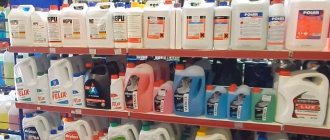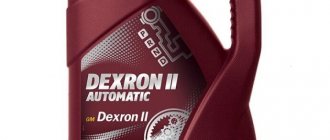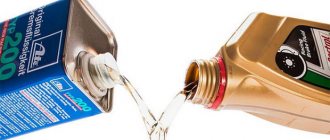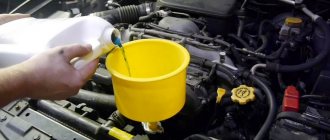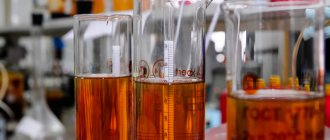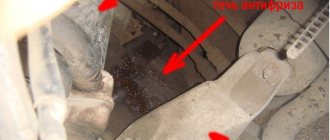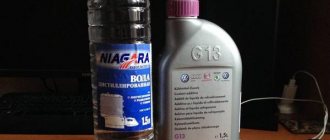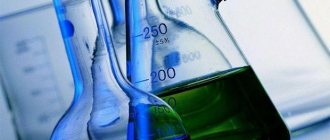Every car owner has at least once had the question of what would happen if you mixed several coolants of different brands. And also is it possible to mix antifreezes of different colors, how blue differs from red and similar thoughts. We will consider these and other questions below so that the reader does not use chemicals in the garage and damage his car.
It is worth noting that, subject to certain conditions, some antifreezes can be mixed. If you do not comply with them, you are guaranteed to “kill” the radiator in two to three years. And it will not be possible to restore it. Therefore, you should think carefully before exposing your car to such a risk.
Composition of antifreeze
Any liquid contains an 80% mixture of distilled water and ethylene glycol. The remaining 20% comes from various types of additives that impart special characteristics to a particular liquid. This applies to standards G11 and 12.
Additives are a key aspect of any formulation. They are needed to neutralize the destructive effect of water and ethylene glycol on the metal parts of the cooling system, in particular the walls of the tubes and radiator.
All additives can be divided into two main types:
- Protective - protect pipes and other elements from aggressive influences by forming a thin layer in the form of a film. Used in antifreeze and antifreeze brand G11.
- Anti-corrosion – neutralize rust during operation or slow down its negative impact. Such additives are more often used in G12 and G12+.
In addition to these, there is another type of additives - hybrid (G13). They combine chemical elements of both categories. Therefore, they are considered universal and suitable for topping up. But not always!
How to dilute antifreeze with distilled water
A decrease in the level of antifreeze in the engine cooling system is a common occurrence. The option of purchasing a new product will be fraught with significant financial investments, and the use of small portable portions does not promise a long life for the motor. The only economical option is to dilute the antifreeze with distilled water. Over time, this additive evaporates.
The optimal proportion of distillate and ethylene glycol is a 1:1 ratio or a lesser proportion of water. At the same time, you should not pour a large amount of distilled liquid on the eve of winter, since the resulting mixture will not be able to protect against low temperatures. Care must be taken to completely change the fluid. In small quantities, distilled water will not change the system; it is not necessary to replace it. When adding distillate, the chemical composition of the initial antifreeze does not change, maintaining its cooling properties.
What do different colors of antifreeze indicate?
As everyone knows, antifreezes differ not only in composition, but also in color. But not everyone can answer the question of what this means. Oddly enough, but first of all, color is needed to quickly distinguish it from plain water. Without dyes, antifreeze is transparent, and because of this it can easily be confused with distilled water, which cannot be used in cold weather.
Bright colors make it recognizable. If a leak appears in the cooling system, it will be immediately noticeable. So, in essence, the color does not indicate the contents of the coolant.
What is antifreeze and what is it for?
The liquid performs two main functions; first of all, it cools the engine, which can heat up to temperatures above 100 degrees. Also, antifreeze does not freeze at low temperatures. Even a product with average performance can withstand up to -40 degrees Celsius.
Modern products are most often made on the basis of dihydric alcohol - ethylene glycol. Propylene glycol is also used, the cost of which is higher, but it emits fewer toxic substances. Pure ethylene glycol freezes at -12.5 degrees. As a result, the freezing temperature drops to -75°C. Typically the water content is at least 35%; manufacturers can change the proportions of mixed components to achieve the desired parameters.
An aqueous solution of ethylene glycol can cause corrosion on metal parts. Therefore, additives must be added to prevent the formation of rust, foaming and cavitation. These additives are also called corrosion inhibitors.
Most manufacturers use ready-made concentrates from one brand for production. Many people purchase raw materials from BASF, so the bulk of the products on sale have a similar composition. Coolants from different price categories always differ in quality.
There is an opinion that to determine compatibility, antifreezes are painted in different colors. In fact, the color does not indicate the composition, for example, in the USA, coolants are often green. There is no general classification, and if the tank breaks, you can immediately notice the leak of a colored substance with fluorescent properties.
Antifreeze classification
The most common are six brands of coolants. These include: antifreeze, G11, G12, G12+, G12++, G13. They are manufactured by different companies and may differ in color and concentration. It is important to note here that shades of antifreeze cannot act as a criterion when selecting a new one. Even with identical composition, coolant from different manufacturers may not match in color.
Differences between antifreezes of different classes:
- Antifreeze - produced in the USSR as a replacement for foreign coolants. Consists of distilled water and ethylene glycol with various additives. They come in green, blue and other colors.
- G11 is a classic antifreeze. The base composition includes ethylene glycol, water and additives (salts of certain acids, borates, nitrites, etc.). It has a long service life. Mostly blue.
- G12 – carboxylate antifreeze. The composition is similar to the previous one, but they additionally contain carboxylic acid compounds. They have a longer lifespan and are available in pink and red colors.
- G12+ is a mixture of water, ethylene glycol and additives (based on carboxylic, silicon, nitric and phosphoric acids). The components that make up such liquids may differ, depending on the manufacturer. Most often produced in red.
- G12++ also refers to hybrid antifreeze. For their production, an organic base and silicic acid compounds are used. The properties are similar to the previous type, and their main difference is their long service life. Available in red and sometimes yellow colors.
- G13 is a relatively new antifreeze. Its base, instead of ethylene glycol, is harmless propylene glycol. Colored in pink or purple shades.
Although the color of antifreeze serves more of a decorative function, it still has weight when choosing a liquid for the cooling system.
What types and colors of antifreeze are there?
Automotive internal combustion engines are cooled with special liquids - antifreeze. Today there are several types of such refrigerants, which differ in color, composition, and characteristics. Therefore, before pouring one or another coolant into the system, you need to familiarize yourself with its parameters. The difference in parameters and the possibility of mixing one antifreeze with another is worth considering in more detail.
Antifreeze classification
In Soviet times, ordinary water or antifreeze, which is a brand of antifreeze, was traditionally used as a coolant. In the manufacture of this refrigerant, inorganic inhibitors are used, which deteriorate after less than 2 years of operation and when the temperature rises to +108 ° C. Silicates present in the composition settle on the inner surface of the cooling system elements, which reduces the cooling efficiency of the engine.
Previously, antifreeze was used as a coolant
There are several types of antifreeze:
- hybrid (G11). This coolant can be green, blue, yellow or turquoise. Phosphates or silicates are used as inhibitors in its composition. Antifreeze has a service life of 3 years and is designed for use with any type of radiator. In addition to the cooling function, hybrid antifreeze has corrosion protection. The subclasses of the liquid in question are G11+ and G11++, which are characterized by a higher content of carboxylic acids;
- carboxylate (G12). This type of coolant refers to organic liquids of red color of different shades. It lasts for 5 years and, compared to the G11 group, provides much better corrosion protection. G12 refrigerants only cover the corrosion areas inside the cooling system, i.e. where it is needed. Thus, the cooling efficiency of the motor is not impaired;
- lobrid (G13). Orange, yellow or purple antifreeze consists of an organic base and mineral inhibitors. The substance forms a thin protective film on the metal in areas of corrosion. The refrigerant contains silicates and organic acids. The service life of antifreeze is unlimited, provided that it is poured into a new car.
There are different types of antifreeze, which differ from each other in composition
Is it possible to mix antifreeze with antifreeze?
Previously, the domestic market could only offer the buyer antifreeze from coolant, so everyone poured it into cars. Now antifreeze is widely used. In this regard, when on forums and in thematic chats people are interested in the possibility of mixing different antifreezes, they often mean antifreeze and antifreeze. Many car enthusiasts think that by combining two different compositions they will get a product with the advantages of the first and second liquid.
Car service specialists claim that mixing antifreeze and antifreeze will not improve the quality and properties of the composition. However, there are situations (especially on long trips) when it is urgently necessary to add coolant to the system, but it is not possible to obtain antifreeze of the same composition as the one that was filled in. Then mixing some brands of antifreeze and antifreeze is allowed, especially if the air temperature drops to zero.
However, after such a procedure, as soon as possible, you will need to drain the mixture, flush the cooling system and add fresh antifreeze.
Antifreeze standards
Coolants for cars are divided into two categories:
- SAE (propylene glycol based);
- ASTM (uses ethylene glycol as a base).
These types are common and the norm in the United States. Other countries have their own gradation:
- AFNOR - France;
- ONORM - Australia;
- CUNA – Italy;
- BS – England;
- GOST - Russia.
The classification is developed in accordance with the majority of cars and the specifics of the engine structure, as well as the prevailing climatic operating conditions of the vehicles. Manufacturers of branded cars, for example Toyota, Volkswagen, General Motors, can boast of distinctive standards, putting forward their own requirements for the type and properties of antifreeze.
Is it possible to mix antifreeze of different colors?
More often, antifreezes that have different colors also differ in characteristics. It's all about the additives used, which have their own shades. New brands of liquids differ from old auto chemicals in their environmental friendliness. On store shelves you can find hybrid, carboxylate, labrid and other formulations. Their difference is not only in colors, but also in composition, as well as performance characteristics.
As noted earlier, various additives give them their properties. It should be noted that mixing antifreezes of different shades, even if they are of the same type, but produced by different manufacturers, is extremely undesirable. The fact is that additives included in the liquid can react, which will lead to neutralization of their beneficial properties.
Let us remind you that mixing them is permissible only in very extreme cases. For example, G13 antifreeze poured into new cars can be combined with other liquids, but its anti-corrosion properties are significantly reduced. No matter what ratio G13 is mixed in, the resulting coolant will still be of significantly worse quality. That is, when combining G11 and 13, you get a liquid with the characteristics of the first antifreeze. In addition, prolonged use of the mixture can cause irreparable damage to the car.
Is it possible to mix TOSOL and antifreeze?
First of all, you should not combine two substances just because they are the same color. It is not recommended to combine products from different manufacturers, because with a similar composition there can be a significant difference in the additives used. Products manufactured to different standards may be identical or very different. But it’s better not to take risks and switch to a similar product only after removing the previous product .
If you want to fill in antifreeze other than what is already in the tank, it is recommended to first drain the old one
Domestic antifreeze - blue TOSOL was originally created for VAZ cars. It is more aggressive than European antifreezes and usually contains silicates. It is not recommended to mix TOSOL with antifreeze, even if they are similar in color. These substances have different compositions, and the additives are not the same. Even if there are no visible problems at first, corrosion may begin over time. Naturally, corroded parts will fail much faster.
Attention!
You cannot mix old-style antifreeze and antifreeze, even if they are the same color!
Is it possible to mix antifreezes with different properties?
When figuring out whether it is possible to mix coolants with different properties with each other, it is worth remembering that G11 and G12+ belong to the same class, and G13 has a completely different composition. A cocktail of G11 and 12+ will retain its protective and anti-corrosion properties, but it should be taken into account that the mixing procedure is difficult to control. In addition, it is not possible to determine in advance what composition of additives will be obtained at the output. It is also worth understanding that by mixing different liquids, you can end up with a combination that includes additives that are undesirable for a given model of engine and radiator. Which will lead to a decrease in the performance of the entire cooling system of the car.
The fact is that G11 antifreeze forms a protective layer on the inner wall of the pipes, which has a positive effect on the cooling process of the engine and all its elements. When mixing blue or green liquids with red, the temperature regime of the motor may be disrupted. However, when adding a small amount of antifreeze with other properties (for example, 0.5 l or less), the changes may be subtle.
Is it permissible to mix different colored coolants?
There are no hard and fast rules allowing or prohibiting mixing coolants of different shades. In many cases it is possible to mix coolants, but there are times when it is prohibited.
Please note that in most cases the following color reference is used:
- G11 - green, blue;
- G12 / 12 + / 12 ++ - pink, red;
- G13 - orange, yellow.
Let's look at this situation in detail using examples.
Red with green
As mentioned, red coolant can be G12/12+/12++ and green coolant can be G11. There are two steps to identify this opportunity. Firstly, make sure that the refrigerant matches the selected class, and secondly, pay attention to the color. Simply put, you should not mix red G12 with green G11.
Red with yellow
There are no restrictions here, because you most likely need to combine G13 and G12, which is not prohibited.
Blue with green
Both shades correspond to class G11, so they can be mixed, but only if produced in the same factory.
Red with red
Reddish coolants G12 / 12 + / 12 ++ can be mixed without any risk. However, be careful if the product is made by different companies. In such circumstances, mixing is undesirable due to the different composition of the additives and differences in the technology used. In other words, 50/50, depending on luck.
Yellow with yellow
Such coolants are equated to G13, which indicates the possibility of their mixing.
Is it possible to mix antifreeze of different brands?
Coolant of different brands can be mixed, provided that they have a similar composition and are also included in the same group. If you are not sure that the parameters of the added and used antifreeze are similar, then you should not put the cooling system at risk.
By mixing liquids of different compositions, you can get a negative reaction. Namely:
- Deposits may appear in the cooling system, leading to the formation of a mixture with even lower performance properties. Additives in different brands of antifreeze may react. The consistency of the coolant may change, for example, thicken, which will lead to a deterioration in its circulation through the system. This leads to clogged pipes and overheating of the motor lubricant and the engine itself. To fix this problem, you will need to completely drain the liquid, replace the pipes, flush the system and fill it with fresh antifreeze.
- Substances from different brands of antifreeze, when mixed, can neutralize each other's work. If a situation arises where you still have to mix them, you will definitely need to drain the mixture, rinse the pipes and radiator. Then add fresh antifreeze.
- When mixing coolants of different compositions, the likelihood of antifreeze foaming increases. Foam accumulates in the expansion tank and system pipes. The situation cannot be corrected by adding anti-foam additives. The intervention of car service specialists will be required to flush the system, after which you need to fill in fresh coolant.
Excessive clogging of the cooling system pipes leads to the following consequences:
- bearings wear out quickly;
- the pump overheats and fails;
- overheating of the cylinder head and other engine components, which leads to its deformation and destruction.
That is, the consequences of mixing can be extremely serious, therefore, you should not expose your car to such a risk. And if such a need arises, the composition of the coolant should be taken into account.
The opinion of car enthusiasts about antifreeze
- Why is antifreeze confused with antifreeze? Briefly and clearly about the sore point. “There is a difference between antifreeze and antifreeze, but these are substances of the same group. Previously, a cooler called “Antifreeze” was used, and later this was what all coolants were called. That is, antifreeze is just a type of antifreeze. You’re not comparing Zaporozhets and cars in general, are you?
Previously, water with the addition of ethylene glycol was poured into the cooling system, so this homemade “cooler” did not freeze. The composition did not cause rupture of the cylinder block and radiator, because it became like a viscous mixture with ice particles. Since the engines used to be cast iron and the radiators were brass, this cooler did not cause rust. This explains the popularity of the first antifreeze. The word “anti-freeze” is translated as “non-freezing”.However, when modern machines appeared, it became impossible to use such a cooler. After all, when passing through the cooling system, it corroded the metal, corrosion formed on the impeller and cylinder head channel machines. To solve this problem, the GosNIIOKhT Institute came up with a new cooler that would prevent the formation of rust. Additives based on inorganic salts were introduced into it, thanks to which a layer resistant to ethylene glycol began to form on the surfaces of the radiator.
Where did the name “antifreeze” come from? The first 3 letters were taken from the name of the department where the composition was produced: “Organic Synthesis Technology”. The ending “ol” was taken from the chemical industry. This is how we got antifreeze called “antifreeze”.
This name not only gained popularity, all coolants began to be called antifreeze. Since in the 70s all successful people drove domestically produced cars, antifreeze was also associated with such cars. As a result, everyone began to think that it could only be used on Russian cars.
Decades passed, with changes in the political system, the attitude towards the Zhiguli became negative, as well as everything related to these cars. Now, when hearing the word “antifreeze”, the image of a low-quality cooler, suitable only for domestic cars, arose in the minds of sellers and buyers. Then antifreeze began to be called any “coolant” intended for domestically produced cars. “The situation is the same here, when not only Jeeps are called jeeps, but all SUVs in general.”
- What to fill - antifreeze or antifreeze?
“Everyone contributed to the creation of confusion in the minds of consumers: wholesalers and retailers who divided the “coolers” into antifreeze and antifreeze. The manufacturer adds additives to modern antifreeze that completely protect the cooling system from rust. Why is this happening? This approach allows you to save money; the low cost of the composition explains its popularity among car owners, and in general, this is the only product that needs to be poured into a Lada car.As for compounds labeled “antifreeze,” everything is completely sad here. Many modern manufacturers have long stopped developing anything new and are selling old-style liquid from the 70s and 80s, bottled in new packaging. What it consists of - silicate, carboxylate, labrid composition - most consultants themselves have no idea.
Several rules for mixing antifreeze
As already noted, different antifreezes differ in composition and have different additives. Most liquids are prohibited from mixing with each other, as this leads to the appearance of sediment and an increase in the thickness of the liquid.
However, some coolants can still be mixed without negative consequences. The question remains: is this necessary? Such a mixture will not cause any particular harm, but if this can be avoided, then there is no need to mix anything. In the worst case scenario, the resulting fluid will not work for long, and can even harm the engine.
Recommendations for mixing individual brands of coolants:
- Do not under any circumstances mix G11 class antifreezes with G12;
- it is allowed to mix liquids with compositions G11 with G12+ and G13;
- in case of emergency, you can mix G12 coolant with G12+;
- It is not recommended to combine G12 fluids with G12++ or G13;
- G12+, G12++ and G13 can be mixed with each other;
- Under no circumstances should antifreeze and any antifreeze be mixed.
Naturally, in an emergency situation, it will be quite difficult to remember what you can mix with, but this will help to avoid negative consequences. When deciding on mixing, you should focus primarily not on color, but on the chemical composition. In addition, do not forget about the presence of a large number of counterfeits on the modern car chemical market. It is simply impossible to predict the consequences of mixing antifreeze with counterfeit liquid.
It is quite difficult for car owners to understand the shades of modern antifreezes. Antifreeze is replaced approximately every two to three years. After replacing the old coolant with a new one, the car owner is not interested in this type of product for a very long time. And during this period, manufacturers can change a lot in the classification and standards of their products. It will also not be possible to purchase antifreeze in large quantities, since it has a certain shelf life.
To avoid mistakes, when purchasing coolant, you should give preference to one manufacturer. It is also a good idea to study the composition of the antifreeze being poured; it is indicated on the packaging.
Antifreeze mixing table
Results
Please note that improper mixing of antifreeze can cause deterioration of the properties of the coolant and, as a result, further problems for the car owner: increased fuel consumption, overheating and reduced engine life, rust on internal components, etc.
To avoid such problems, follow the recommendations given in the article and the manufacturer's requirements.
If different brands/colors of coolant need to be mixed during operation, do so, but if possible, flush the system immediately and add new coolant according to the manufacturer's recommendations.
Therefore, mixing antifreeze with antifreeze and fluids of the G11 and G12 classes should be avoided.
How to check antifreeze compatibility
It is easy to find out the compatibility of various coolants even at home or in the garage. True, this method will not give one hundred percent confidence that after mixing two antifreezes, the composition will work normally and perform its functions in the car.
The method is as follows. It is necessary to take a sample of the liquid that is poured into the cooling system and mixed in a separate container with the one that is planned to be added. You can take a sample using a syringe from the expansion tank or use the drain hole.
After receiving a sample of antifreeze from the car, pour it into any, preferably transparent, container and add to it approximately the same amount of coolant that you want to add to the cooling system. Leave the mixture for 5 – 10 minutes.
If mixing did not lead to a violent reaction in the container, foam did not appear on the surface of the composition, or sediment fell to the bottom of the container, then most likely the antifreezes are compatible with each other. If at least one of the listed reactions is detected, it is strongly recommended to avoid mixing such antifreezes. To make the test more accurate, mixed liquids can be heated to 80 - 90 °C.
What to do if you have filled in antifreeze of a different classification?
The VChSLV channel in its video showed the process of flushing the cooling system, as well as replacing antifreeze.
Mixing different types of refrigerants in a car's cooling system and not flushing it out promptly will cause deposits to form. As soon as possible, cleaning is done, which will require at least 10 liters of distilled water.
Execution process:
- Open the hood and let the car engine cool.
- Place a container under the antifreeze drain hole or under the radiator into which the waste will flow.
- Use a wrench or your hands to remove the plug. The spent substance will begin to drain.
- When the liquid comes out, screw the lid on.
- Fill the cooling system with distillate. Its volume should correspond to the amount of liquid drained. You can add citric acid to the water (at the rate of 1 kg per 10 liters of distillate for severe contamination or 800 grams per 10 liters for non-critical deposits).
- Start the engine and let it run for about 15-25 minutes.
- Unscrew the drain plug and wait until the water comes out of the system.
- Remove the expansion tank. Sediment collects at its bottom. Clean the tank thoroughly. If the contamination is strong and is not washed out, the container is replaced with a new one and then replaced.
- If the drained liquid is too dirty and contains traces of scale or deposits, repeat the flushing procedure again. Carry out cleaning until the water drained from the system becomes clear. Then you can fill in new antifreeze. We recommend assessing the condition of the cooling system pipes. If they are severely clogged and flushing does not solve the problem, the hoses should be replaced. Also look at all gaskets and seals. If they are worn out and in critical condition, these components must be replaced.
Fake antifreeze
Actually, it seems to me that the topic is completely covered! BUT what I would like to say finally is - have you ever wondered why some formulations, say branded or serious companies, are expensive, but there are formulations that are very cheap?
The same G13 antifreeze, made under the patronage of Volkswagen (usually purple), can cost 300 rubles per liter
And the yellow one, let’s say the same G13, produced somewhere unknown and not clear by whom, can cost the same money only for a 5 liter canister.
The whole point here is “fake”, because a high-quality liquid will not be cheap, and it will also meet all the characteristics and safety requirements, such as:
- Will boil over 100 degrees (usually 105 to 110 degrees)
- When boiling, will not ignite
- Will not lose characteristics
When you buy cheap antifreeze, you simply cannot test it, but it’s not uncommon for it to boil well below 100 degrees! Because of this, your engine can simply overheat and fail.
And when mixing cheap and expensive options, always think, HAVE YOU CHECKED THE QUALITY OF THE INEXPENSIVE PRODUCT? Does it meet the standards? Otherwise, you will simply ruin the branded expensive and high-quality liquid!
Therefore, most antifreezes can be mixed, but everything must be done wisely!
Now this is a useful video, I recommend it to everyone.
I’ll finish this, read our AUTOBLOG.
Similar news
- The antifreeze (TOSOL) has darkened and turned brown. Why? Let's sort out the...
- How to check the cap (plug) of the expansion tank? Instructions...
- Can antifreeze evaporate: on its own from the expansion tank...
Add a comment Cancel reply
Useful tips
As you can see, today it is more difficult to answer whether it is possible to mix antifreezes of different colors, brands and manufacturers. Just a few years ago the answer would often have been negative, but today the situation has changed somewhat. Color is no longer so important, the composition is more universal, the additives used in antifreeze are more unified, etc.
The only thing that makes you wonder are reports of cooling system breakdowns after mixing antifreeze or using unsuitable fluids. It turns out that the compatibility problem still remains and it is quite real.
Against this background, it is better to adhere to this rule: optimally mix 2 antifreezes that belong to the same group and have the same color. For example, G13. In turn, it is better not to mix G12++ yellow and G13 purple, choosing a more suitable option for topping up.
Let us also note that some car enthusiasts today claim that modern antifreeze (TL) is an analogue of G 11 antifreeze. So, antifreeze can only be mixed with antifreeze. In practice, mixing antifreeze and antifreeze leads to sedimentation!
We also recommend reading the article on how to flush a car’s engine cooling system from rust. From this article you will learn how to flush the cooling system, as well as what tools can be used to solve this problem.
It should also be added that you can mix antifreeze with water only in certain proportions (50/50, 60/40, etc.). In short, the freezing point of antifreeze in concentrate form itself is not as low as it might seem.
To make it clear, water freezes at zero, pure antifreeze at -7, but mixing antifreeze and distilled water in a 1:1 ratio allows you to get a freezing point of about -30 degrees Celsius.
In this case, a larger amount of water in the composition will lead to the freezing temperature changing, and downward. For example, 70% of water and only 30% of antifreeze will freeze at -15 degrees Celsius (average data). It turns out that you shouldn’t try to greatly dilute the concentrate to save money.
Moreover, when purchasing, it is important to pay attention to the form in which the antifreeze comes, ready-made or in the form of a concentrate. As a rule, today a concentrate is sold, which must be diluted with water yourself, taking into account the manufacturer’s recommendations.
If the manufacturer supplies the finished product, then he mixes the antifreeze to the optimal concentration of ethylene glycol and additives. In this case, there is no need to add water.
